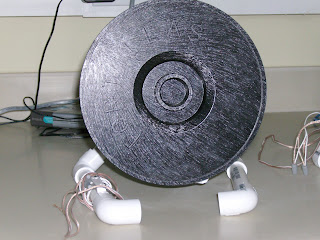
Today some of the group, including myself, woke up at 7 to go and check the crab traps that we set out last night. Our hopes were high...well at least mine were....that we were going to catch some crabs. Unfortunately, the only thing we caught were a bunch of ants. Most of the traps that held the bait still had the bait in them and were just covered with ants. Other buckets contained no bait and we think something came by and stole the bait from the trap. One of the traps had dog prints next to it...which may explain why the some of the baits went missing. So, that experiment turned out to be a flop. In the future, we think using bigger buckets to catch the crabs will probably fix the problem. But despite the lack of crabs, the few of us that went out got to see a beautiful sunrise and got first dibs on the breakfast =)
After breakfast the gang went out to Bastimentos (a very large, gorgeous island) to catch more hermit crabs. We started off with about 18, but in order to do the orientation experiments (described before) we needed to catch about 40 more. In the first 30 minutes we only caught about 7 crabs...and we all started getting worried that finding 40 hermit crabs would prove an impossible task. But Humberto and Matt found a dead tree right next to the ocean that ended up being the crab castle. Crab after crab was pulled from this dead tree stump thing, some of which were very large! In total, we pulled roughly 40 crabs just from this one tree!!! A little further down the way, Humberto again hit the jack pot of hermit crab hiding places. In a small area we were able to collect about 30 small sized hermit crabs. Relief swept over everyone's faces after learning we had finally found all the crabs we needed.

The second task of the morning: Snorkeling around a coral reefs to look for urchins for Maria. Most of us were unsuccessful at finding them though. But we still had a great time on the reef and saw a ton of cool things including file clams, basket stars, parrot-fish, and jellyfish.
We also stooped at the mangroves for a few minutes to pick up larvae traps we had put down 3 days earlier. The traps are simply a thick mess square that we tied to the bottom of the sea and another tied to a mangrove at the surface of the water. The larvae settle in these traps and we collect them to look at later.
Lunch came and went and we were given a long afternoon break for all our hard work. Most of the the group went into town to do some shopping at the local stores. After we got back from town the first thing we did was split the crabs into different groups for the crab orientation experiments. Unfortunately, while I was grabbing a crab, he latched onto my finger and refused to let go! OOOWWW! I finally pulled the damn thing off after 8 minutes when I realized I had lost all feeling in the tip of my finger and realized it would just be better to pull him off. After that I decided I just better not handle anymore of the crabs (it was the second time today I got pinched...I think they all hate me haha)

We then split up into groups to do some research. Some of us first looked at the larvae we had caught in the traps earlier that day. Some of the things we found were copepods, crab megalope, diatoms, and isopods. We also caught some thing we were not able to identify, one of which looked spider like...gross. haha. The other group spent a few hours locked in "the cave." The cave is a storage room in the bottom of the research facility where we do the crab orientation experiments. We have to do it in a dark room in order for there to be no shadows for the crabs. We changed up the protocol of the experiment a little bit from how I explained it the other day because we noticed the crabs were able to see us even though we were trying to stay out of their sight. So we tried using a red light (crabs can't see as well in this light) and we hid behind trash bags to try and fix the problem. Hopefully this will work much better.
After working on these two things before dinner, we reversed groups and continued going research for awhile longer after enjoying a good dinner and a very large, loud thunderstorm. =)

















